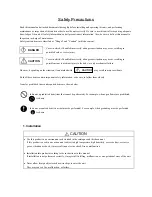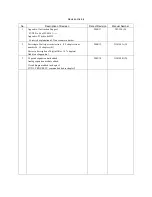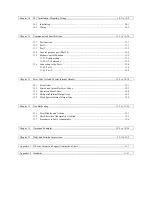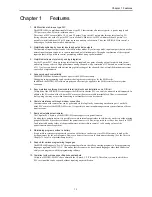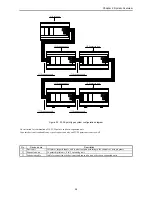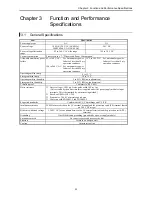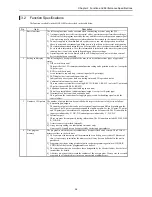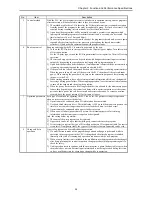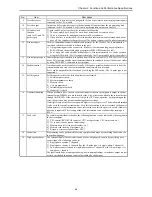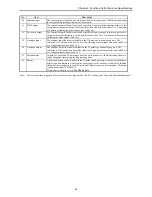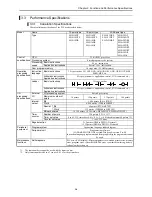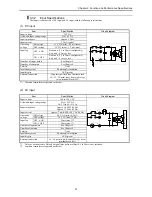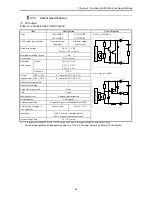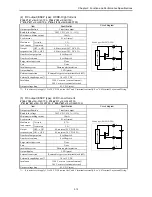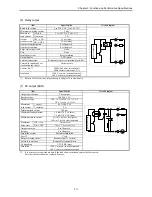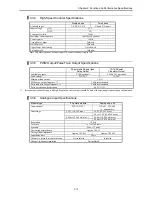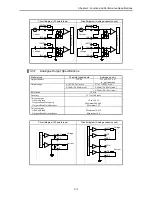
Chapter 3 Function and Performance Specifications
3-2
3.2
Function Specifications
The functions available in the MICRO-EH are described in the table below.
No.
Item
Description
1
Basic functions
The following functions can be executed when constructing a system using the PLC.
1] An input signal is received from the control object, operations are performed according to
the contents of the program created by the user and the results are output as an output signal.
Also, operation results and progress information can be retained in the internal output area.
2] Power is supplied to the main module, system starts to run, and the operation described
above is performed continuously until the power is shut down or the system stops running.
3] The information retained internally can be extracted by a device connected externally or can
be set in other information. Also, this information is initialized at the time the system starts
running, but it can also be retained depending on the user settings.
4] Operating status can be confirmed with the LED display of each unit or with an external
device that has been connected.
2
Setting and display
The following have been provided for the user to set or confirm various types of operation
status:
1] DIP switch (basic unit)
This specifies the CPU communication function setting and operation mode, etc. (except for
10-point type)
2] RUN switch (basic unit)
It can instruct to run and stop. (external input for 10-point type)
3] LED display (basic unit and expansion unit)
Indicates the power system status, operating status and I/O operation status.
4] Communication connector (basic unit)
This can connect external devices using RS-232C, RS-485, RS-422. (only the 23-point and
28-point types with RS-485, RS-422)
5] Expansion connector (basic unit and expansion unit)
This allows installation of additional input/output. (except for 10-point type)
6] Terminal block (basic unit and expansion unit)
This performs the connections for supplying power, and for handling signals with the
control object.
3
Number of I/O points The number of points that can be controlled with respect to the control object is as follows:
1] External inputs/outputs
The number of points that can be use for external inputs/outputs differs depending on the
basic unit. The 10-point type cannot expand the inputs/outputs. For the 14-point, 23-point
and 28-point types, a maximum of 4 expansion units can be connected. The I/O numbers for
inputs are indicated by X, WX, DX and outputs are indicated by Y, WY, DY.
2] Internal outputs
These are areas for temporarily storing information. The I/O numbers include M, WM, DM,
R, WR, DR.
3] A timer counter is provided internally.
4] Array (corresponding to a substitution statement only)
An array of I/O numbers can be expressed by enclosing by parentheses.
4
User program
memory
The program in which the control contents have been described can be stored. This FLASH
memory resides in the basic unit.
1] The contents of this memory will be maintained even if the power is shut off. Because of
this, it is necessary to initialize the memory since it may have undefined after the unit is
purchased.
2] Programming is done using peripheral units such as programming software (LADDER
EDITOR) for the H-series programmable controllers.
3] The instructions that can be used are those designated by the H-series ladder. See the list of
instructions for details.
4] A battery is not required to retain the contents of the user program. Always save the created
programs to a floppy disk just in case an unexpected problem occurs.
Summary of Contents for HIDIC MICRO-EH
Page 1: ...HITACHI PROGRAMMABLE CONTROLLER APPLICATION MANUAL NJI 350B X ...
Page 12: ...MEMO ...
Page 14: ...Chapter 1 Features 1 2 MEMO ...
Page 50: ...Chapter 4 Product lineup and wiring 4 18 MEMO ...
Page 196: ...Chapter 5 Instruction Specifications 5 146 ...
Page 263: ...Chapter 11 Communication Specifications 11 10 MEMO ...


